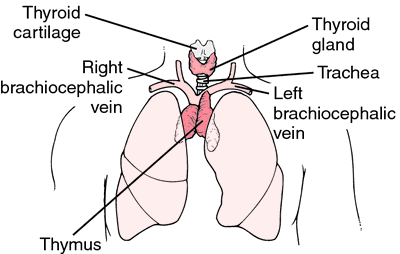thymus
[thi´mus]a ductless gland lying in the upper mediastinum beneath the sternum; it reaches its maximum development during puberty and continues to play an immunologic role throughout life, even though its function declines with age. During the last stages of fetal life and the early neonatal period, the reticular structure of the thymus entraps immature stem cells arising from the bone marrow and circulating in the blood. The thymus preprocesses these cells, causing them to become sensitized and therefore capable of maturing into a specific differentiated type of lymphocyte. After sensitization by the thymus, the cells reenter the blood and are transported to developing lymphoid tissue, where they seed the cells that eventually become T lymphocytes, a type essential to the development of cell-mediated immunity. If the thymus is removed or becomes nonfunctional during fetal life, the lymphoid tissue fails to become seeded with the sensitized lymphocytes and the body's cell-mediated arm of immunity fails to develop. It is this arm of immunity that is mainly responsible for rejection of organ transplants and resistance to intracellular microbial infection, and perhaps plays a role in natural resistance to cancer.

Thymus.
Miller-Keane Encyclopedia and Dictionary of Medicine, Nursing, and Allied Health, Seventh Edition. © 2003 by Saunders, an imprint of Elsevier, Inc. All rights reserved.
thy·mus
, pl.thy·mi
,thy·mus·es
(thī'mŭs, thī'mī, thī'mus-ez), [TA] [TA] A primary lymphoid organ, located in the superior and anterior mediastinum and lower part of the neck, that is necessary in early life for the normal development of immunologic function. It reaches its greatest relative weight shortly after birth and its greatest absolute weight at puberty; it then begins to involute, and much of the lymphoid tissue is replaced by fat. The thymus consists of two irregularly shaped parts united by a connective tissue capsule. Each part is partially subdivided by connective tissue septa into lobules, 0.5-2 mm in diameter, which consist of an inner medullary portion, continuous with the medullae of adjacent lobules, and an outer cortical portion. It is supplied by the inferior thyroid and internal thoracic arteries, and its nerves are derived from the vagus and sympathetic nerves.
Synonym(s): thymus gland
[G. thymos, excrescence, sweetbread]
Farlex Partner Medical Dictionary © Farlex 2012
thymus
(thī′məs)n. pl. thy·muses
A small glandular organ that is situated behind the top of the breastbone, consisting mainly of lymphatic tissue and serving as the site of T cell differentiation. The thymus increases gradually in size and activity until puberty, after which it begins to atrophy.
The American Heritage® Medical Dictionary Copyright © 2007, 2004 by Houghton Mifflin Company. Published by Houghton Mifflin Company. All rights reserved.
thy·mus
, pl. thymi, pl. thymuses (thī'mŭs, -mī, -mŭs-ĕz) [TA]A primary lymphoid organ, located in the superior mediastinum and lower part of the neck, which is necessary in early life for the normal development of immunologic function. It reaches its greatest relative weight shortly after birth and its greatest absolute weight at puberty; it then begins to involute, and much of the lymphoid tissue is replaced by fat. The thymus consists of two irregularly shaped parts united by a connective tissue capsule. Each part is partially subdivided by connective tissue septa into lobules, which consist of an inner medullary portion, continuous with the medullae of adjacent lobules, and an outer cortical portion.
Synonym(s): thymus gland.
Synonym(s): thymus gland.
[G. thymos, excrescence, sweetbread]
Medical Dictionary for the Health Professions and Nursing © Farlex 2012
thymus
A small flat organ of the lymphatic system situated immediately behind the breastbone, that is apparent in children but inconspicuous after puberty. The thymus processes primitive LYMPHOCYTES so that they differentiate into the T cells of the immune system. It also differentiates T cells into T1 and T2 classes, a process that is influenced by the early environment of the individual.Collins Dictionary of Medicine © Robert M. Youngson 2004, 2005
thymus
an endocrine gland situated in the neck region of most vertebrates, but close to the heart in mammals. It produces LYMPHOCYTES which then move to lymph nodes. The thymus produces a hormone called thymosin which causes the lymphocytes to form ANTIBODY-producing plasma cells immediately after birth, but regresses in adult animals.Collins Dictionary of Biology, 3rd ed. © W. G. Hale, V. A. Saunders, J. P. Margham 2005
Thymus
An organ near the base of the neck that produces cells that fight infection. It is at its largest at puberty, then declines in size and function during adult life.
Gale Encyclopedia of Medicine. Copyright 2008 The Gale Group, Inc. All rights reserved.
thy·mus
, pl. thymi, pl. thymuses (thī'mŭs, -mī, -mŭs-ĕz) [TA]A primary lymphoid organ, located in the superior mediastinum and lower part of the neck, which is necessary in early life for the normal development of immunologic function.
[G. thymos, excrescence, sweetbread]
Medical Dictionary for the Dental Professions © Farlex 2012